When phone manufacturers ditched the 3.5mm jack on their devices, the justification was to create room to slot in larger batteries and bigger antennae. That excuse doesn’t hold up in 2024, particularly when you consider that a small phone like the Zenfone 10 somehow has a 3.5mm jack, a 5000mAh battery, and all the extras you need in a modern phone.
But all other brands already moved away from the analog jack, and are instead pushing their wireless earbuds as a way to listen to music on the go. Outside of a few budget and mid-range devices, you won’t find the 3.5mm jack on most phones these days. This is what Moondrop wants to fix. The audio manufacturer is nothing if not bold in its vision, and its latest product is the MIAD01, an Android phone that has a 3.5mm jack as well as a balanced 4.4mm port — which is unheard of.

In addition to the ports, the MIAD01 has a decent DAC, and the design is intriguing to say the least. I wasn’t sure about the feasibility of such a device, but I used the MIAD01 for the better part of a week, and it has a few unique advantages. While there’s no shortage of dongle DACs like the Fiio KA13, being able to plug in any IEM or headset into a phone is just much more convenient, and the MIAD01 has standout sound quality. It is also able to drive demanding planar headsets without breaking a sweat, and that’s just an added bonus.
However, the MIAD01 also has to do all the other phone-related features in addition to audio playback, and this is where it doesn’t measure up to regular phones. The software doesn’t have any custom features, the cameras just aren’t worth the hassle, and the hardware isn’t quite the best in this segment. But if you don’t care about all of that and just need a phone for daily use that also doubles as a portable audio player, the MIAD01 has a lot to offer.
Moondrop MIAD01: Pricing and availability
(Image credit: Harish Jonnalagadda / Android Central)
Moondrop launched the MIAD01 in China in April 2024, and the phone is now on sale globally. It is available in a single variant with 12GB of RAM and 256GB of storage, and it costs $399 at audio retailers like HiFiGo. While the phone is sold with 256GB of internal storage, it has a MicroSD slot that lets you add up to 2TB of additional storage — ideal if you have a lot of offline music.
Moondrop MIAD01: Design and screen

(Image credit: Harish Jonnalagadda / Android Central)
The MIAD01 has a distinct visual design, and the phone is decked out in a grey color scheme that has the same sci-fi aesthetic as the rest of the brand’s products. The orange accents for the power and volume buttons give the design a little bit of added flair, and I like the fact that the cameras at the back don’t jut out from the design.

(Image credit: Harish Jonnalagadda / Android Central)
The defining characteristic of the MIAD01 is the presence of 3.5mm and 4.4mm ports at the top, and to accommodate the analog connectors, Moondrop increased the thickness of the top third portion. This is a good design choice as it ultimately doesn’t affect usability, and because it extends to the entire width of the phone, there is no wobble when using it on a table.
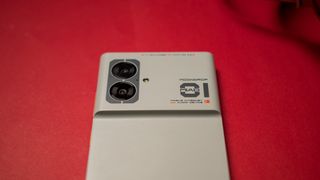
(Image credit: Harish Jonnalagadda / Android Central)
The back and sides are made out of plastic, but the build quality is decent, and the buttons have good tactility. There isn’t much in the way of branding either; you get the Moondrop logo along with the model name at the back.
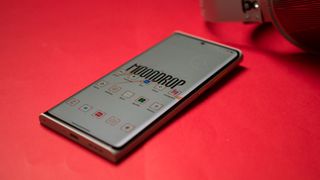
(Image credit: Harish Jonnalagadda / Android Central)
Another interesting design choice is the dual-curved OLED panel; the curvature is just enough that you get the benefits of a curved screen, but not so much that it limits usability. There is enough room on the sides to hold the phone comfortably, and this allows the MIAD01 to differentiate itself a little better.
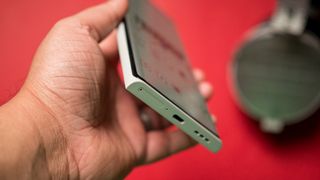
(Image credit: Harish Jonnalagadda / Android Central)
What isn’t great is that the curved design doesn’t extend to the back, so you’re left with an asymmetrical aesthetic that’s just uncomfortable. Sure, the phone looks cool, but the flat back tends to dig into the palm, and it makes holding and using the MIAD01 much more awkward than it needs to be.
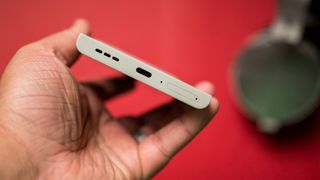
(Image credit: Harish Jonnalagadda / Android Central)
There’s a good reason that every other phone that has a curved screen has symmetric curves at the back, but that isn’t the case here, and it ultimately makes using the MIAD01 tedious. On that note, there’s no ingress protection of any kind, but that’s a given considering the phone has analog ports.
Rounding out the design, the MIAD01 has dual SIM card slots in addition to a dedicated MicroSD slot, giving you the ability to add up to 2TB of storage above and beyond the 256GB of built-in storage.
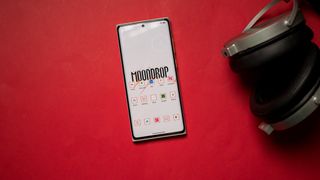
(Image credit: Harish Jonnalagadda / Android Central)
Switching over to the screen, the MIAD01 has a 6.7-inch OLED panel with 120Hz refresh. It has good colors and contrast levels, and while the brightness level isn’t the best in its class, I didn’t see any issues in this regard. There’s stereo sound, but as the device is limited to Widevine L3, it doesn’t play streaming content at 1080p — it maxes out at 720p.
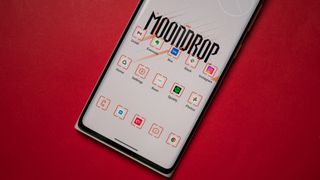
(Image credit: Harish Jonnalagadda / Android Central)
As the software itself is barebones, you don’t get many customization options. The phone has an always-on mode, but you just get a digital clock and unread notification icons along with the battery level. The screen refresh is set to Auto out of the box, but you can manually toggle between 60Hz and 120Hz.

(Image credit: Harish Jonnalagadda / Android Central)
On the whole, I like the design of the MIAD01, and the only issue with the phone is the lack of curves at the back.
Moondrop MIAD01: Sound quality

(Image credit: Harish Jonnalagadda / Android Central)
Obviously, a key talking point of the MIAD01 is the audio potential. As I mentioned above, the phone has a single-ended 3.5mm jack in addition to the balanced 4.4mm port, and the latter in particular is interesting. The phone has plenty of power to spare, and having used it with the likes of the Fiio FT5, Moondrop Venus, and other planar headsets, I didn’t see any issues in this regard.
The MIAD01 is just as reliable at driving sensitive IEMs, and there’s no background hiss whatsoever. I tested it with the Fiio FX15, Thieaudio Prestige LTD, Sennheiser IE200, and a half-dozen other IEMs, and it was terrific throughout.
You get dual Cirrus Logic DAC hardware, and the MIAD01 is similar to the MoonRiver 2 dongle DAC in this regard. If anything, the sound is almost identical, and you get a neutral sound with a hint of warmth. The DAC has good dynamics and imaging, and the overall sound is refined — it is equivalent to the best dongle DACs.
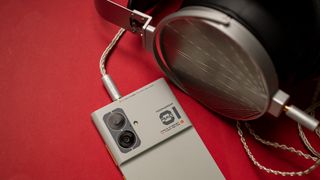
(Image credit: Harish Jonnalagadda / Android Central)
If you prefer a warm signature, there’s a service dubbed AudioConsole that comes bundled with the phone, and it lets you emulate a tube amp sound. The difference is noticeable, but I prefer the default sound characteristic. The phone doesn’t have AptX codecs, so you’re limited to the usual SBC and AAC in addition to LDAC.
What I like the best is that the phone has granular volume adjustment, unlike Android’s asinine slider. There’s a nifty toggle that allows you to stream music in the background, and you can use it with any audio and video streaming service.
Moondrop MIAD01: Hardware and battery

(Image credit: Harish Jonnalagadda / Android Central)
Moondrop says the MIAD01 is powered by MediaTek’s Dimensity 7050, but the device info shows it is using the MT6877V (Dimensity 1080) instead. Both platforms use the same set of cores: there are two Arm v8 Cortex A78 cores that go up to 2.6GHz, along with six Cortex A55 cores that hit 2.0GHz. You get a Mali-G68 GPU, and it definitely shows its age when playing demanding titles.
To Moondrop’s credit, the MIAD01 doesn’t have noticeable lag in daily use. It handles mundane tasks like browsing and social media with relative ease, and because the interface doesn’t have any overt customization, it is fluid. However, this is not a gaming phone, and if you play anything but casual titles, you’ll see a lot of jitter and unstable framerates.
Swipe to scroll horizontallyCategoryMoondrop MIAD01OSAndroid 13Display6.7-inch 120Hz OLED, 2400 x 1080, HDR10+ChipsetMediaTek Dimensity 1080, 6nmRAM12GB LPDDR4XStorage256GB UFS 3.1, MicroSD slot up to 2TBRear camera 164MP Sony IMX686, f/1.9, 4K at 30fps, EISRear camera 28MP OmniVision OV8856 wide-angle lensFront camera32MP OmniVision OV32BIngress protection❌ConnectivityWi-Fi 6, Bluetooth 5.2, NFC, limited Sub-6 5G bandsSecurityOptical in-screen sensorAudioSingle-ended 3.5mm, balanced 4.4mm, built-in DAC, stereo soundBattery5000mAh, 33W USB PD 3.0 charging
The phone is sold in a single variant, and it has 12GB of LPDDR4X RAM and 256GB of UFS 3.1 storage. Again, it isn’t the latest storage or memory standard available today, but there are no issues in usability, and with the MicroSD slot, you can easily boost the addressable storage to up to 2TB.

(Image credit: Harish Jonnalagadda / Android Central)
Coming to the connectivity side of things, the MIAD01 has Wi-Fi 6, Bluetooth 5.2, NFC, and a limited selection of 5G bands: 1/3/5/7/8/20/28/41/77/78. The in-display fingerprint sensor is fast to authenticate and doesn’t have any issues with reliability, but it is located a little lower on the screen.
Switching over to the battery, the MIAD01 has a 5000mAh battery that lasts a day consistently. There’s no charger in the box, but the phone uses the USB PD 3.0 standard, and goes up to 33W. It’s annoying that Moondrop didn’t bundle a charger in the box, but as you can use any USB PD charger, it isn’t too much of a hassle.
Most other mid-range phones have better hardware and connectivity, and it’s clear that Moondrop didn’t set out to create a powerful phone; the focus is instead on delivering the best audio performance, and it managed to achieve that.
Moondrop MIAD01: Cameras
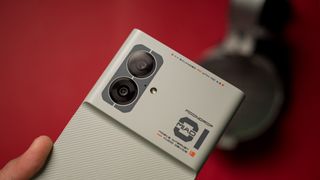
(Image credit: Harish Jonnalagadda / Android Central)
Tuning the cameras on a phone takes a lot of resources and effort, and it’s not something smaller brands can manage. This is evident when using the MIAD01; the phone has outdated sensors and no camera tuning whatsoever, and the result is that it takes sub-par shots in any given situation.
What’s particularly telling is that even the brand doesn’t think the cameras are up to scratch, as it notes in its marketing materials: it’s not good, but it works. That sums up the state of the cameras on the MIAD01, and I don’t really have much to add to that.
The MIAD01 has a 64MP f/1.9 main camera that uses a Sony IMX686 sensor, and it is joined by an 8MP OmniVision OV8856 wide-angle lens, and a 32MP camera at the front that features OmniVision’s OV32B sensor. The interface is similar to what you get on most phones; the shooting modes are arranged in a ribbon at the bottom, and you get toggles throughout the viewfinder.
Image 1 of 6






Daylight shots are passable at best, with the phone able to deliver decent colors in outdoor scenarios with good lighting. There are issues with focusing, foliage rendition isn’t accurate, and the AI mode tends to oversaturate colors. The wide-angle lens isn’t worth the hassle; it is barely usable in daylight situations, and the resultant shots have muted colors and graining.
When it comes to low-light conditions, the MIAD01 is objectively the worst camera I’ve used in a very long time. There’s so much noise that it reminds me of phones from over a decade ago, and you don’t even get a Night mode.
I used phones with the IMX686 quite a bit, and the sensor itself isn’t at fault — it has the potential to deliver great photos. This is down to the software, and it is possible to get decent shots by installing a different camera utility. On that note, the MIAD01 has level 3 Camera2 API integration, so you should be able to install an aftermarket utility like GCam and get much better photos.
Moondrop MIAD01: Software
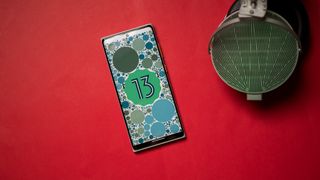
(Image credit: Harish Jonnalagadda / Android Central)
It’s a monumental undertaking to design a custom Android skin, and most smaller brands choose to use a vanilla interface with limited customizability. That’s the case with the MIAD01 as well; it has a plain UI that doesn’t have any overt styling, and that’s a good move. You get a standard notification pane, large toggles, and Material You accent colors.
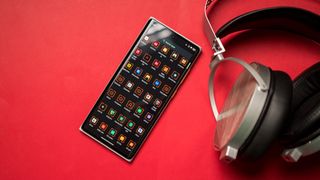
(Image credit: Harish Jonnalagadda / Android Central)
The biggest annoyance is the stylized icons, and this makes the UI look a bit chintzy; this is similar to what Chinese manufacturers did a half-decade ago. The device runs the November 2023 security update out of the box, but there is an OTA available that installs the May 2024 update. However, you’re still limited to Android 13, with no mention of when Android 14 will become available.
There isn’t much else to talk about the software. The overall UI is unfinished, and it reminds me of the Nothing Phone 1 back when it launched; you get all the requisite features, but there isn’t any customizability.
Another egregious omission is the Play Store and associated Google services — you’ll need to sideload these onto the device, so if that’s not something you’re willing to do, you should consider another phone. Once you have it installed, it’s easy enough to set up the phone the way you want.
Updates are also an unknown, and while the brand hasn’t shared how many platform versions the device will receive, it’s a good bet that it won’t go beyond Android 15 — if that.
Moondrop MIAD01: The competition

(Image credit: Harish Jonnalagadda / Android Central)
The Pixel 7a continues to be a great choice if you want a great mid-range phone. The Pixel 8a is now available, but that device is costlier at $500, and while it has better hardware, the Pixel 7a is a great value — particularly if you can get it at a discount. As with most phones these days, there’s no 3.5mm jack on the device, so you will need to invest in a dongle DAC if you’re interested in pairing the phone with IEMs or a balanced headset.
The OnePlus 12R is a terrific option to consider, with the phone offering standout hardware and decent cameras at the back. Similar to the Pixel 7a, you’ll need to buy a USB DAC to get the most out of the device, but if you want a powerful phone with lots of useful features, the 12R is my recommendation.
Moondrop MIAD01: Should you buy it?

(Image credit: Harish Jonnalagadda / Android Central)
You should buy this if:
You need a phone with 3.5mm and 4.4mm jacksYou need great sound qualityYou want a phone that’s also a digital audio playerYou need a MicroSD slot
You shouldn’t buy this if:
You want polished softwareYou use the cameras a lotYou want the Play Store preinstalledYou need timely updates
The way I think of the MIAD01 is that it is a sleek digital audio player with a 5G modem. The design is closer to other mid-range phones, and while the in-hand feel isn’t great thanks to the asymmetrical curves, it is light. The biggest selling point of the device is the fact that you get 3.5mm and 4.4mm ports, and the sound quality is on par with most dongle DACs — no small feat. The MIAD01 can easily drive planar headsets, so that isn’t an issue.
There are other things the device gets right; the 6.7-inch 120Hz OLED panel has good colors and is great in daily use, and the 5000mAh battery lasts a day with ease. I would have liked better hardware, because as it stands, the Dimensity 1080 doesn’t quite measure up to demanding tasks. Similarly, the cameras just aren’t in the same league as other $400 phones.
Then there’s the software. You get a clean interface without too much bloatware, but it doesn’t have much in the way of features. You’ll need to sideload Google’s services before the phone becomes usable, and it’s still on Android 13. Considering the state of the software, there’s no telling when it will switch to Android 14, much less Android 15.
That said, the built-in ports and decent DAC make the MIAD01 stand out quite a bit, and if you’re interested in a digital audio player that doubles as a phone, then yes, it is worthy of consideration. It isn’t as good as a standalone player or a regular phone, but as a two-in-one device that lets you listen to high-res music on the go, the MIAD01 is unrivaled.





GIPHY App Key not set. Please check settings